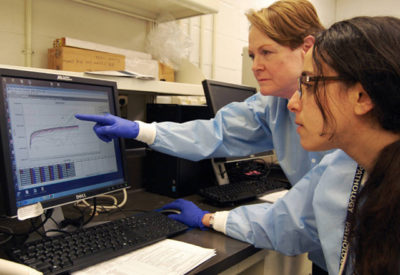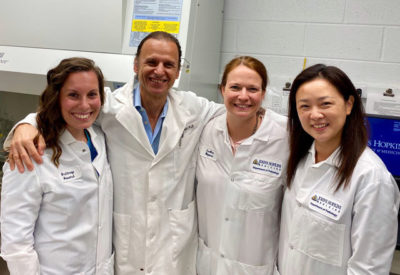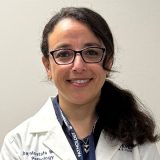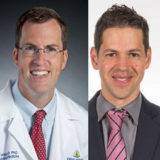
The Department of Pathology has a long and rich history of fighting pandemics. In fact, the first Director of Pathology, William Henry Welch, helped lead America's effort to fight the great influenza pandemic of 1918. Today, the Department of Pathology's efforts to help manage the COVID-19 crisis extends from front line clinical diagnostics to the development of novel therapeutic approaches.

COVID-19 Testing
The clinical molecular virology laboratory in Pathology, led by Heba Mostafa, M.B.B.Ch., Ph.D., was one of the first laboratories in the United States to implement a high throughput, in-house SARS-CoV-2 molecular diagnostic test. The initial test, which analyzes a nasopharyngeal or throat swab, was implemented for the first time on March 11, 2020.
Several thousand tests have been tested using the initial laboratory developed test. Since March, eleven molecular platforms/assays have been implemented throughout the entire Microbiology Division and more than 331,000 tests performed. The laboratory tests an average of 1,800 samples per day and continues to increase testing capacity.
The laboratory is currently assisting with the genomic surveillance of SARS-CoV-2 for tracking novel, predominant, and variants of concern.

The clinical immunology laboratory, led by Mario Caturegli, M.D., M.P.H., launched a serum test on April 10, 2020 to detect the presence of antibodies against the SARS-CoV-2 virus. This test can be used not only to assess COVID-19 prevalence but also to aid diagnosis, as described in a recent publication in the prestigious Annals of Internal Medicine.
The immunology laboratory also offers tests to measure cytokines such as IL-6, which are useful to monitor the inflammatory burden of COVID-19, select the patients who would benefit the most from tocilizumab (a drug that blocks the IL-6 receptor), and predict the onset of a devastating complication known as "cytokine storm”.
Ongoing Research
Efforts continue to improve diagnostic testing and to develop new treatments, so that the Department of Pathology can provide cutting-edge patient care for COVID-19. From developing a new serology test to determine who has recovered from the infection to coming up with new approaches to treat infected patients using plasma antibodies from recovered patients to working to develop a novel vaccine, our researchers are learning about various aspects of this virus.
Read more about individual COVID-19 research projects in our department below.

Autopsy for Elucidation of Disease Process and Collection of Tissue for Researchers
Clinicians consenting family members for autopsies on deceased COVID positive patients should call the Legacy Gift Rapid Autopsy Program number at 1-800-886-6696 at any time 24/7 so that consenting for research on specimens can also be completed.
The effect of the COVID-19 virus on organs besides the lungs has only begun to be investigated. The Johns Hopkins Autopsy Service is prepared to perform focused autopsies on patients testing positive for COVID-19. Histologic and electron microscopy evaluation will be completed on multiple organs and frozen and other tissue as well as blood or fluid samples can be collected for laboratories which are prepared to receive samples. Please contact Dr. Edward Gabrielson to be added to the collection protocol.

Immune Response Biomarkers for COVID-19 Patient Stratification
The Larman Laboratory of Precision Immunology develops and deploys cutting edge molecular assays to characterize human immune responses. Three technologies are being employed for detailed analyses of the antibody response to SARS-CoV-2, and certain types of autoimmune responses that may underlie life-threatening COVID-19. The Larman Lab is also developing a novel nucleic acid test called cRASL-seq, which is capable of efficiently tracking SARS-CoV-2 variants as they arise.

Elucidating the Genetics of SARS-CoV-2 and the Association with Disease Progression
Our research interest is in viral genomics, and the correlation of viral polymorphisms with viral fitness and disease severity.
Whole genome sequencing of SARS-CoV-2 isolated strains will be performed with a focus on phylogenetics and genetic epidemiology of transmission. The project will dissect the genetic diversity of the virus in Baltimore/DC and the differences between the viral genomes in the beginning of the outbreak versus later with a study of the genomic change overtime. The study will also examine the accumulation of viral mutations as a factor of prolonged infection. Re-infections and positives after vaccination will be a main focus to reveal the associations between certain viral variants and the evasion of the natural or vaccine induced immune responses.

Developing a T-cell Vaccine for COVID-19
Over time infectious agents such as SARS-CoV-2 accrue mutations. These mutations can make the virus more pathogenic by helping it evade the immune system. However, the virus faces a fitness cost in making these changes. When comparing various SARS isolates both over time and from different animal species, there are parts of the virus that are strictly conserved. We believe that these conserved regions are the most vulnerable proteins within the virus and are the focus of our vaccine strategy.
Vaccine development has traditionally relied on the generation of antibodies to neutralize infectious virus. Although successful in dealing with many pathogens, this strategy commonly neglects vulnerable parts of a virus. T-cells represent another avenue of attack. T-cells can recognize infected host cells and kill them by direct cell-to-cell contact. If properly induced, T-cells can target parts of a virus not open to antibody attack.
Our vaccine links highly conserved and functionally important segments of SARS-CoV-2 that can be targeted by T-cells into one immunogen. We are now designing and testing “vehicles” in which to deliver the immunogen.

Understanding the Role of Immune Cells in COVID-19
T cells are critical players in infectious disease, autoimmunity, wound healing, and cancer. Yet, even for virus-specific T cell responses, it has been difficult to identify and study them. Current approaches are limited in terms of sensitivity, throughput, and/or ease of use. We address these challenges by engineered magnetic nanoparticle tools called artificial antigen presenting cells (aAPCs) for isolating and expanding human virus-specific T cells with great specificity and to large numbers. Our approach has increased throughput and translatability by streamlining processes for T cell culture and enrichment, as well as particle and detection reagent production. These innovations dramatically increase the multiplexing ability and decrease the barrier of entry for other researchers/clinicians and commercial labs to adopt this technology and investigate virus-specific T cells. The ability to expand T cells to large numbers enables unique downstream analyses, lead to better understanding of disease and the generation of novel therapies. We are now using our core aAPC technology to address the urgent need for analysis of immune responses to the COVID-19 pandemic. Our ability to quantitate and expand COVID-19-specific T cells will help us understand our body's ability to fight the virus, develop new diagnostics, and novel anti-COVID-19 therapies.
Visit Dr. Jonathan Schneck's Research Lab
Visit The Johns Hopkins Translational ImmunoEngineering Center

Harnessing the Power of Convalescent Plasma for Treatment of COVID-19
Our laboratory research is focused on using blood plasma from recovered coronavirus patients to treat those who were exposed to the virus or those who have COVID-19. This work harnesses the power of antibodies developed by recovered patients to treat current patients.
- Human Anti- SARS-CoV-2 plasma as post-exposure prophylaxis: a randomized, blinded Phase 2 trial will compare the efficacy and safety of Human Anti-SARS-CoV-2 plasma vs. control (SARS-CoV-2 non-immune plasma) among adults (age ≥ 18yrs) who have been exposed to COVID-19 but have not manifested symptoms.
- Human Anti- SARS-CoV-2 plasma to treat outpatients: a randomized, blinded Phase 2 trial will compare efficacy and safety of Human Anti-SARS-CoV-2 plasma vs. control (SARS-CoV-2 non-immune plasma) in outpatients with COVID-19 who manifest symptoms
In addition to supporting the clinical trials, our laboratory is investigating the composition of convalescent plasma. We have demonstrated that while most COVID-19 convalescent individuals develop a strong antibody response, the neutralizing antibody titers and binding avidity are highly heterogeneous in CCP with up to 20% of units not having detectable neutralizing antibody levels. In addition, compared to healthy blood donor control plasma, CCP has significantly higher plasma levels of IFN-g, IL-10, IL-15, IL-21 and MCP-1. Using multiplexed Fc array binding assays, as well as a variety of validated functional antibody response assays, we have reported that CCP provides additional antiviral activities in the form of antibody-dependent cellular cytotoxicity, complement activation and phagocytosis. Thus, CCP may provide benefits beyond just the neutralizing antibody, and it will be important to understand these differences.
